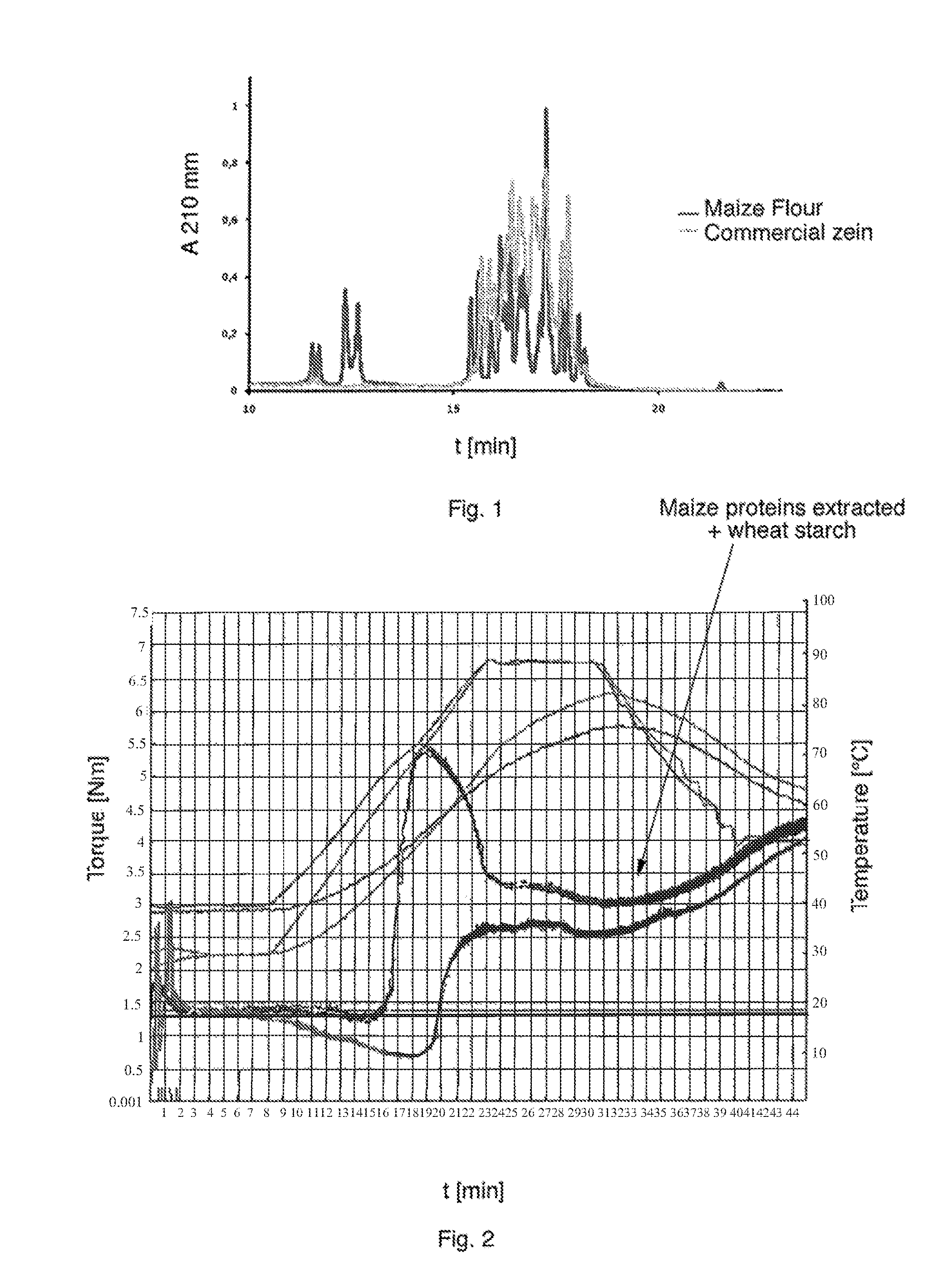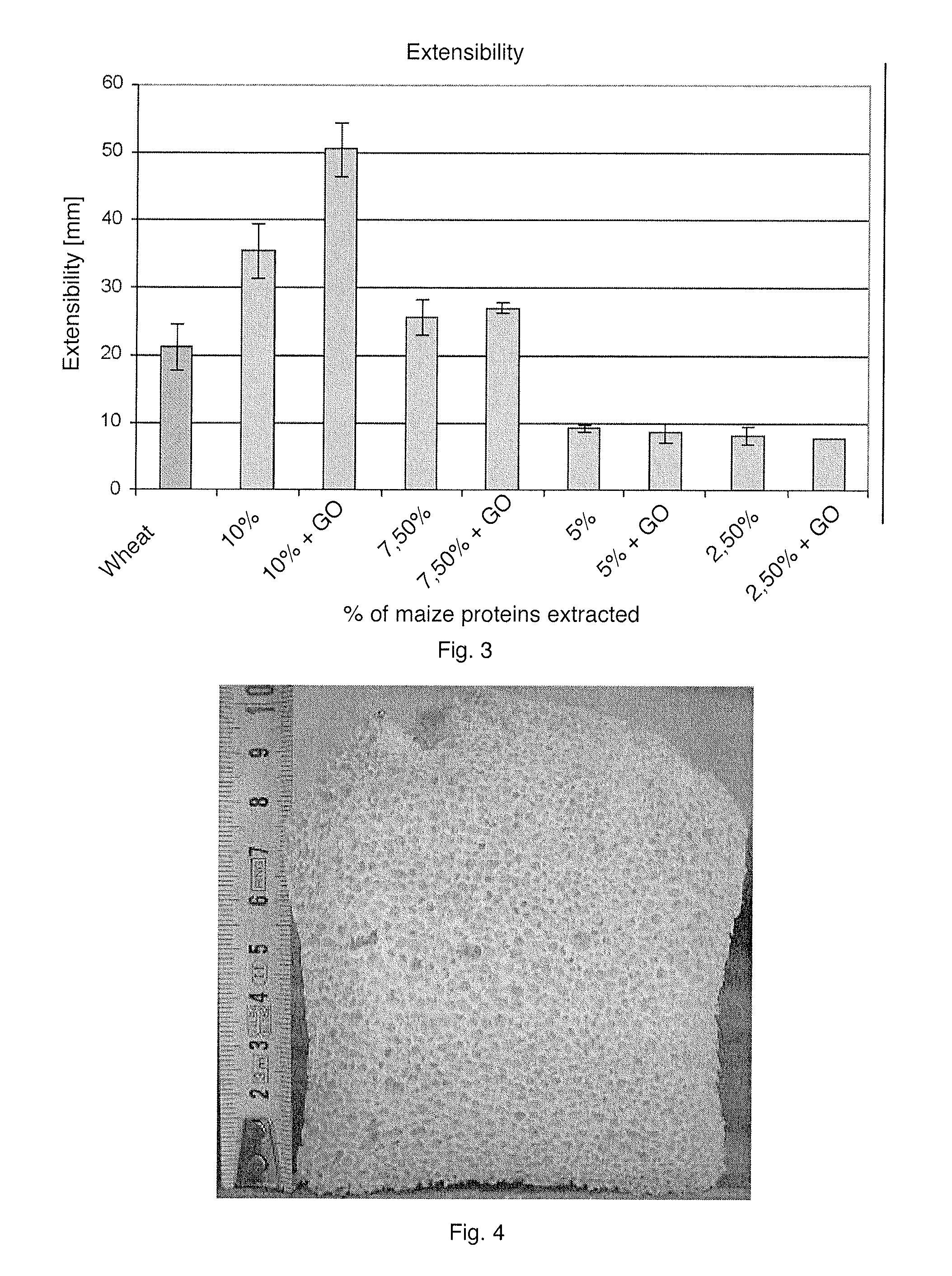Method for the production of maize proteins and use of said proteins for the production of gluten-free bakery products and pasta
a technology of maize protein and production method, which is applied in the field of method for the production of maize protein and the, can solve the problems of degradation and unusability
- Summary
- Abstract
- Description
- Claims
- Application Information
AI Technical Summary
Benefits of technology
Problems solved by technology
Method used
Image
Examples
example 1
Extraction
[0107]The white maize flour was extracted repeating the extraction step four times (proportion 1:8) with a quantity of aqueous solution of isopropanol of 50% containing a phosphate buffer (pH=7.6).
[0108]The extraction solution was prepared as follows:
[0109]1. Solution KH2NaPO4: 1.14 g dissolved in 1 L (890 g) of aqueous isopropanol 50% (v / v) (c=0.009 mol / L)
[0110]2. Solution Na2HPO4*H2O: 1.49 g dissolved in 1 L (890 g) of aqueous isopropanol 50% (v / v) (c=0.009 mol / L)
[0111]3. The Na2HPO4*H2O solution is taken to pH=7.6 with the solution KH2NaPO4.
[0112]The albumins and globulins are not pre-extracted, but are dissolved with the zein during the alcohol extraction.
[0113]400 L of aqueous solution of isopropanol at 50% containing a phosphate buffer are heated to 50° C. in a container with a double heating thickness with a capacity of 500 liters and able to be closed; afterward, the flour is added to the solution. As soon as the mixture has reached the required 50° C., the mixing ...
example 2
Gluten-Free Bread
[0115]A recipe for gluten-free bread was developed using the proteins extracted from white maize flour. The quantities used are shown in Tables 1 and 2. The flour mix in Table 2 is described in Table 1.
TABLE 1flour mixPercentagesIngredients(weight / weight)Zein and glutelin from white 20maize flour extracted as perthe present inventionWheat starch60Rice flour20Total100
TABLE 2Percentage on the flour mix (on dryIngredientsbase of dough) (%)Flour mix (made according to Table 1)Glucose oxydase (Gluzyme Mono 100000.03BG, Novozymes. Denmark)Yeast5Sunflower seed oil6Dextrose2Salt1Water90
[0116]All the dry ingredients are mixed at 40° C. until a homogeneous mix is obtained in a food-mixer with a heating jacket. Water at 40° C. is added to the mix and everything is mixed for 1-3 minutes until a film is formed, similar to that formed by gluten. Then the oil is added and mixing is continued for 8 minutes. The dough is made to rise in a 400 g mold for 30 minutes at a temperature o...
example 3
Gluten-Free Pasta
[0118]A recipe for gluten-free pasta was developed using the protein extracted from white maize flour. The quantities used are shown in Table 4.
TABLE 4Pasta mixPercentagesIngredients(weight / weight)Zein and glutelin from white maize flour 15extracted as per the present inventionWheat starch65Rice flour20Total100
[0119]Advantageously, all the dry ingredients are mixed with about 0.3% of the enzyme transglutaminase, until a homogeneous dough is obtained in a food-mixer. The humidity of the dough is preferably around about 30%. The gluten-free pasta was extruded using the following temperature gradient: 50-60-50-20° C. The pasta was dried in a drier at 40° C. and at about 70% humidity for 8 hours. With this recipe it is possible to make various types of pasta such as quills, macaroni or spaghetti.
[0120]After a sensory analysis performed by a panel of trained tasters, three parameters of the structure of the cooked pasta were evaluated, with a scale of intensity from 0 (p...
PUM
| Property | Measurement | Unit |
|---|---|---|
| temperature | aaaaa | aaaaa |
| temperature | aaaaa | aaaaa |
| temperature | aaaaa | aaaaa |
Abstract
Description
Claims
Application Information
 Login to View More
Login to View More - R&D
- Intellectual Property
- Life Sciences
- Materials
- Tech Scout
- Unparalleled Data Quality
- Higher Quality Content
- 60% Fewer Hallucinations
Browse by: Latest US Patents, China's latest patents, Technical Efficacy Thesaurus, Application Domain, Technology Topic, Popular Technical Reports.
© 2025 PatSnap. All rights reserved.Legal|Privacy policy|Modern Slavery Act Transparency Statement|Sitemap|About US| Contact US: help@patsnap.com



